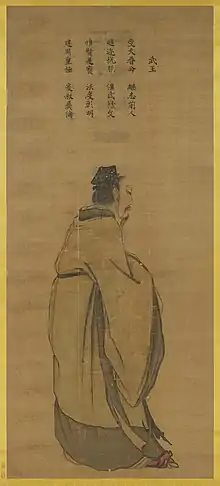King Wu of Zhou
King Wu of Zhou (Chinese: 周武王; pinyin: Zhōu Wǔ Wáng; died c. 1043 BCE) was the founder and first king of the Zhou dynasty. The chronology of his reign is disputed but is generally thought to have begun around 1046 BCE and ended with his death three years later.[1]
| King Wu of Zhou 周武王 | |||||||||||||||||||||||||||
|---|---|---|---|---|---|---|---|---|---|---|---|---|---|---|---|---|---|---|---|---|---|---|---|---|---|---|---|
 Depiction of King Wu by Ma Lin | |||||||||||||||||||||||||||
| King of the Zhou dynasty | |||||||||||||||||||||||||||
| Reign | 1046–1043 BCE | ||||||||||||||||||||||||||
| Predecessor | King Zhou of Shang (Shang dynasty) | ||||||||||||||||||||||||||
| Successor | King Cheng of Zhou | ||||||||||||||||||||||||||
| Born | Ji Fa (姬發) | ||||||||||||||||||||||||||
| Died | 1043 BCE Haojing, Zhou dynasty | ||||||||||||||||||||||||||
| Spouse | Yi Jiang | ||||||||||||||||||||||||||
| Issue | King Cheng of Zhou Yu, Marquis of Tang Da Ji Lan | ||||||||||||||||||||||||||
| Dynasty | Zhou | ||||||||||||||||||||||||||
| Father | King Wen of Zhou | ||||||||||||||||||||||||||
| Mother | Tai Si | ||||||||||||||||||||||||||
| Chinese name | |||||||||||||||||||||||||||
| Chinese | 周武王 | ||||||||||||||||||||||||||
| Literal meaning | Martial King of Zhou | ||||||||||||||||||||||||||
| |||||||||||||||||||||||||||
| Personal name | |||||||||||||||||||||||||||
| Traditional Chinese | 姬發 | ||||||||||||||||||||||||||
| Simplified Chinese | 姬发 | ||||||||||||||||||||||||||
| |||||||||||||||||||||||||||
King Wu's ancestral name was Ji and given name Fa. He was the second son of King Wen of Zhou and Queen Taisi. In most accounts, his older brother Bo Yikao was said to have predeceased his father, typically at the hands of King Zhou, the last king of the Shang dynasty; in the Book of Rites, however, it is assumed that his inheritance represented an older tradition among the Zhou of passing over the eldest son.[2] (Fa's grandfather Jili had likewise inherited Zhou despite two older brothers.)
Upon his succession, Fa worked with his father-in-law Jiang Ziya to accomplish an unfinished task: overthrowing the Shang dynasty. During the ninth year of his reign, Fa marched down the Yellow River to the Mengjin ford and met with more than 800 dukes.[3] He constructed an ancestral tablet naming his father Chang King Wen and placed it on a chariot in the middle of the host; considering the timing unpropitious, though, he did not yet attack Shang. In 1046 BC, King Wu took advantage of Shang disunity to launch an attack along with many neighboring dukes. The Battle of Muye destroyed Shang's forces and King Zhou of Shang set his palace on fire, dying within.
King Wu – the name means "Martial" – followed his victory by establishing many feudal states under his 16 younger brothers and clans allied by marriage, but his death three years later provoked several rebellions against his young heir King Cheng and the regent Duke of Zhou, even from three of his brothers.
A burial mound in Zhouling town, Xianyang, Shaanxi was once thought to be King Wu's tomb. It was fitted with a headstone bearing Wu's name in the Qing dynasty. Modern archeology has since concluded that the tomb is not old enough to be from the Zhou dynasty, and is more likely to be that of a Han dynasty royal. The true location of King Wu's tomb remains unknown, but is likely to be in the Xianyang-Xi'an area.
Wu is considered one of the great heroes of China, together with mythical Yellow Emperor and legendary Yu the Great.
Family

Queens:
- Yi Jiang, of the Lü lineage of the Jiang clan of Qi (邑姜 姜姓 呂氏), the first daughter of the Great Duke of Qi; the mother of Song and Yu
Sons:
- Prince Song (王子誦; 1060–1020 BC), ruled as King Cheng of Zhou from 1042 to 1021 BC
- Second son, ruled as the Monarch of Yu (邘), the ancestor of the surname Yu (于)
- Third son, Prince Yu (王子虞), ruled as the Marquis of Tang from 1042 BC
- A son who ruled as the Marquis of Ying (應)
- A son who ruled as the Marquis of Han
Daughters:
- First daughter, Da Ji (大姬)
- Married Duke Hu of Chen (1071–986 BC)
- Youngest daughter, personal name Lan (蘭)
- Married Duke Yǐ of Qi (d. 933 BC)
Ancestry
| Zulei (1192–1158 BC) | |||||||||||||||||||
| King Tai of Zhou | |||||||||||||||||||
| King Ji of Zhou | |||||||||||||||||||
| Tai Jiang of Pang | |||||||||||||||||||
| King Wen of Zhou (1125–1051 BC) | |||||||||||||||||||
| Tai Ren of Zhi | |||||||||||||||||||
| King Wu of Zhou (d. 1043 BC) | |||||||||||||||||||
| Tai Si of Youshen | |||||||||||||||||||
References
- These dates are those of the People's Republic of China's official Xia–Shang–Zhou Chronology Project, although they remain controversial.
- Book of Rites, Tan Gong I, 1. Accessed 4 Nov 2012.
- Sima, Yi. Records of the Grand Historian.